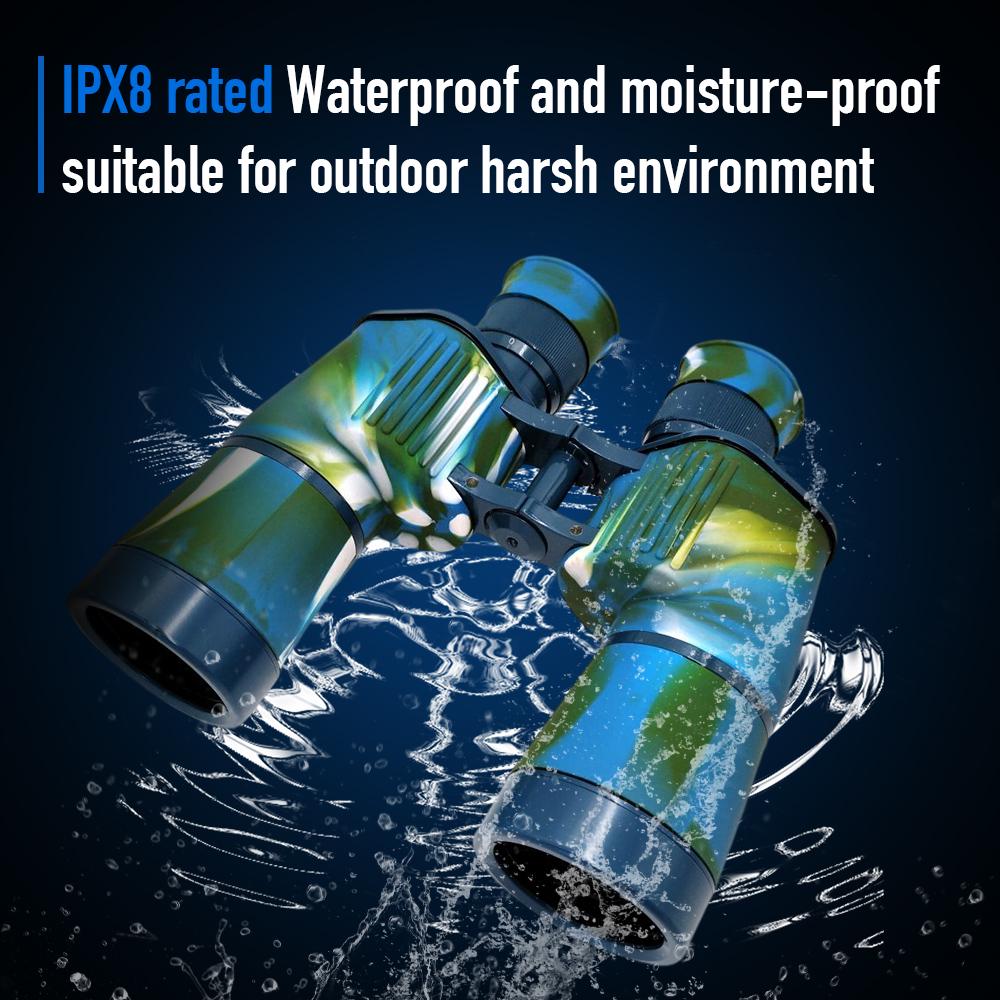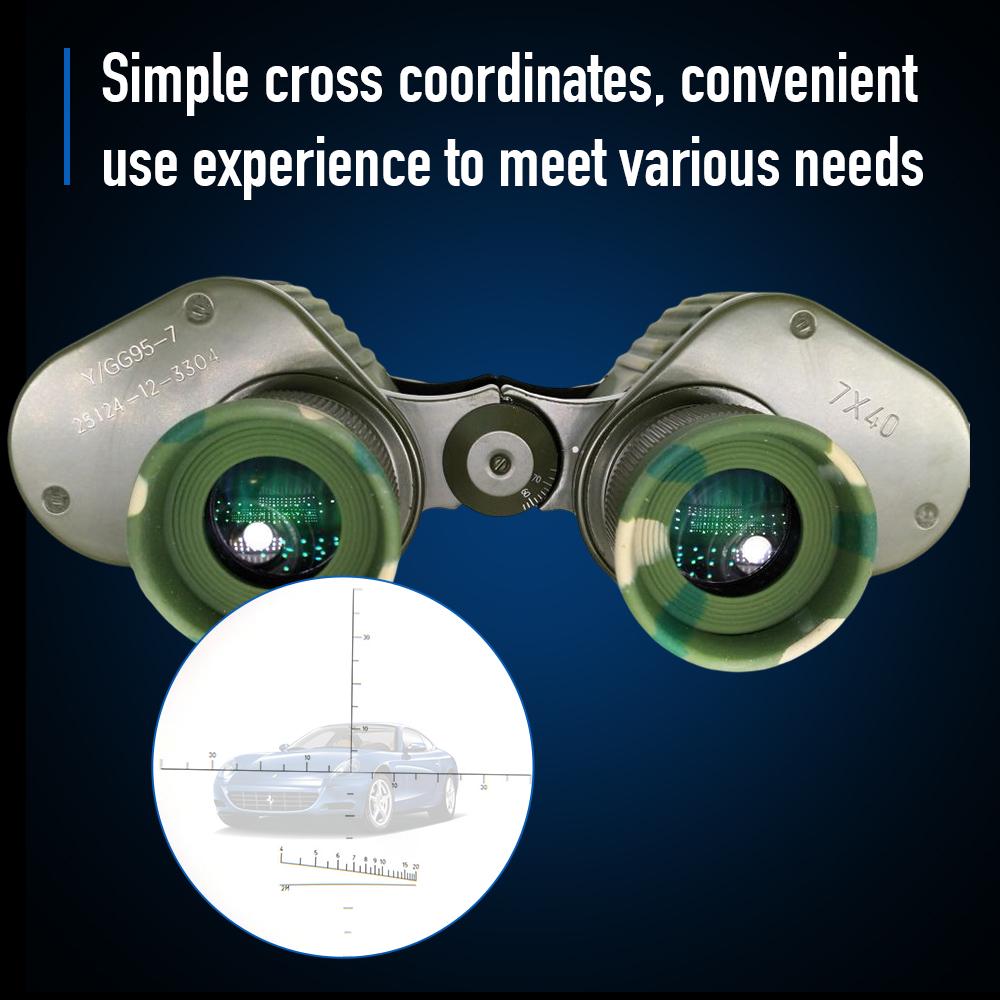For many people considering purchasing a telescope, the decision can be overwhelming. Telescopes vary significantly in price, and with such a high investment, it’s only natural to hesitate. One common misconception is that military telescopes are always superior. In numerous movies and TV shows, we often see the appearance of binoculars. The binoculars presented in these works have diverse functions. They feature two adjacent circular fields of view, which are filled with various markings for aiming and positioning. Such vivid depictions make many people believe that military binoculars must be more advanced in performance.but the truth is that military and civilian telescopes serve different purposes, have distinct features, and are designed for very different environments. Understanding these differences can help potential buyers make more informed choices based on their needs.
1. Optical Systems and Reticles
The optical quality of telescopes is mainly determined by the lenses, prisms, coatings, and the optical system. Among these,The optical systems of military and civilian telescopes are fundamentally different in their design and functionality, primarily due to the distinct environments and objectives they are built for.
- Military Telescopes: Most military telescopes are equipped with reticles, also known as crosshairs, which are useful for targeting, ranging, and measuring. These reticles often come with illuminated markingsto enhance visibility during low-light conditions, such as night operations. Military telescopes are designed with a larger exit pupil, allowing users to wear gas masksor protective headgear while still having a clear view. For this reason, the exit pupil distance is often longer (sometimes up to 70-80 mm) to accommodate the use of protective equipment like forehead guards or eye masks.

- Civilian Telescopes: Civilian telescopes, typically used for astronomy or terrestrial viewing, do not usually feature illuminated reticles. The focus is on high optical performance and ease of use in non-combat scenarios. Most civilian models also offer a more standard exit pupil size, optimized for general use, which may not be as adaptable to extreme conditions.

2. Optical Performance and Build Quality
Military telescopes are engineered for ruggedness, reliability, and long-term performance in harsh environments, while civilian telescopes focus on optical quality and usability in more controlled settings.
- Military Telescopes: The materials used in military telescopes are of the highest quality, often metal(such as aluminum alloysor titanium), ensuring they can withstand the physical stresses of the field. These materials help protect the telescopes from impacts, temperature extremes, and harsh weather. The lenses used are also of superior quality, providing clearer, sharper images with reduced stray light and reflections. The magnification is designed to match the aperture size and deliver the best resolution possible for long-distance viewing. In order to obtain a larger field of view, the magnification usually does not exceed 10 times. But civilian telescopes will pursue seeing more details, such as bird watching. Additionally, military scopes are built to be resistant to fogging and mold growth, with features like internal nitrogen filling to protect the lenses and ensure consistent optical performance even in humid or wet conditions.

- Civilian Telescopes: In contrast, civilian telescopes may use less durable materials, such as plastic, in their construction. While high-quality civilian telescopes still provide excellent optics, they are generally not designed to withstand the same physical or environmental stresses as military-grade equipment. The lenses may not be as resistant to fogging, and the build quality may not hold up as well in extreme conditions.

3. Environmental Testing
Military telescopes undergo rigorous environmental testing to ensure they can perform in the toughest conditions, including extreme temperatures, vibrations, and exposure to water. This is especially important in military operations, where telescopes are often exposed to harsh environmental factors.
- Military Telescopes: Before being released for use, military telescopes typically undergo a variety of tests, including:
- Vibration Tests:These are carried out to ensure that the telescopes remain operational under physical shocks or during movement. Usually, the test involves checking whether the lens will neither tilt nor break when the device is dropped from a height of 2 meters.
- Temperature Tests: They are tested at extreme high temperatures (up to 55°C) and low temperatures (down to -45°C) to ensure they remain functional in any climate.
- Water-proofTests: These tests ensure the scopes are waterproof or capable of handling immersion in water for short periods.

- Air Tightness Tests: To prevent moisture from entering the device and causing fogging or mold growth inside the lens housing. Some military telescopes even include built-in dryers that prevent condensation by filling the internal housing with dry nitrogen.The purity of the filled nitrogen gas is usually higher, generally not lower than 99%.
- Civilian Telescopes: Civilian telescopes, on the other hand, may not undergo such stringent testing. While many high-end civilian telescopes are weather-resistant and durable, they generally do not go through comprehensive environmental durability testslike their military counterparts. Some models may include protective features like waterproofing, but these are usually not tested to the extreme levels that military telescopes undergo.Meeting military testing standards will also increase costs. Moreover, there are some excessively high standards, such as the requirement for usability at minus 30 degrees Celsius, which are not necessary for most people. Even the waterproof function is not required. You need to purchase according to your needs to avoid wasting money.
4. Design and Cost
Due to the superior materials, rigorous testing, and specialized features, military telescopes tend to be much more expensive than civilian models. The additional costs are justified by the increased performance, reliability, and durability required in military applications.
- Military Telescopes: The cost of military telescopes is significantly higher due to the use of high-end materials, advanced optics, and the additional cost of quality control, testing, and military-grade certifications. Furthermore, military telescopes often require the ability to function in a variety of specialized situations—such as being used in combat, extreme temperatures, or in total darkness—which necessitates more complex design and manufacturing processes.

- Civilian Telescopes: Civilian telescopes, while still providing high-quality optics for astronomical and terrestrial observation, are typically designed to be more affordableand user-friendly. They don’t require the same level of durability or extreme environmental protection, which allows for a lower production cost. However, the optical performance of civilian telescopes has improved significantly in recent years, especially in models designed for amateur astronomers or nature observers.
5. Specialized Military Optical Instruments
While most military telescopes share similarities with civilian telescopes in terms of basic functionality (magnification, resolution, etc.), there are many other specialized optical instruments used in military applications. These devices are often based on the same principles as telescopes but are adapted for specific tasks.
- Military Optical Instruments: Some of the military optical instruments derived from telescopes include:
- Rangefinders: Used to measure the distance to a target.
- Periscopes: Used in submarines or armored vehicles to allow observation from within.
- Sights: Aimed at improving targeting accuracy for firearms, artillery, or tanks.
- Artillery Mirrors: Used for long-range surveillance and targeting in artillery operations.
- Reconnaissance Theodolites: Precision instruments used for surveying and mapping the terrain.
These devices are engineered with highly specific features and additional functions, such as ranging scales or targeting reticles, which are not typically found in civilian telescopes.


6. Technological Integration
With the rapid advancement of modern technology, many traditional military optical devices have been integrated with electronic enhancements such as laser targeting, infrared capabilities, and digital imaging. For instance, some military scopes feature thermal imaging, digital rangefinding, or ballistic computers to improve targeting accuracy and enhance situational awareness.
While electronic integration in civilian telescopes is also growing—particularly in the realm of smart telescopes used for astronomy—these innovations are more often found in specialized military systems.
Conclusion
While military telescopes and civilian telescopes may look similar at first glance, their differences are vast in terms of design, durability, optical performance, and intended use. Military telescopes are built for extreme conditions and require high-end materials, rigorous testing, and specialized features, making them more durable, reliable, and expensive. Civilian telescopes, on the other hand, are generally designed for more controlled environments, focusing on providing excellent optical performance for hobbies like astronomy or nature observation at a more affordable price.
For casual users, a civilian telescope is usually sufficient, but if you’re looking for a telescope that can endure extreme weather, heavy physical stress, and provide precision performance over long distances, a military-grade model may be the better choice—albeit at a significantly higher price. Understanding the specific needs and environments in which you plan to use the telescope will help you make the right decision between military and civilian models.
- Military Telescopes: The materials used in military telescopes are of the highest quality, often metal(such as aluminum alloysor titanium), ensuring they can withstand the physical stresses of the field. These materials help protect the telescopes from impacts, temperature extremes, and harsh weather. The lenses used are also of superior quality, providing clearer, sharper images with reduced stray light and reflections. The magnification is designed to match the aperture size and deliver the best resolution possible for long-distance viewing. In order to obtain a larger field of view, the magnification usually does not exceed 10 times. But civilian telescopes will pursue seeing more details, such as bird watching. Additionally, military scopes are built to be resistant to fogging and mold growth, with features like internal nitrogen filling to protect the lenses and ensure consistent optical performance even in humid or wet conditions.



